
Sambandar, also referred to as Tirujnana Sambandar, was a Shaiva poet-saint of Tamil Nadu who lived sometime in the 7th century CE. According to the Tamil Shaiva tradition, he composed an oeuvre of 16,000 hymns in complex meters, of which 383 (384) hymns with 4,181 stanzas have survived. These narrate an intense loving devotion (bhakti) to the Hindu god Shiva. Sambandar died when he was sixteen years of age. The surviving compositions of the poet-saint are preserved in the first three volumes of the Tirumurai, and provide a part of the philosophical foundation of Shaiva Siddhanta.

Appar also referred to as Tirunavukkaracar or Navukkarasar, was a seventh-century Tamil Shaiva poet-saint. Born in a peasant Shaiva family, raised as an orphan by his sister, he lived about 80 years and is generally placed sometime between 570 and 650 CE. Appar composed 4,900 devotional hymns to the god Shiva, out of which 313 have survived and are now canonized as the 4th to 6th volumes of Tirumurai. One of the most prominent of the sixty-three revered Nayanars, he was an older contemporary of Sambandar.
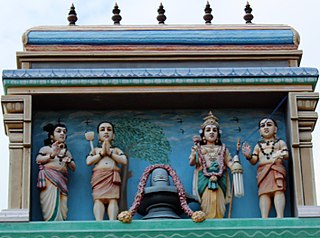
Sundarar, also referred to as Chuntarar, Chuntaramurtti, Nampi Aruran or Tampiran Tolan, was an eighth-century poet-saint of Tamil Shaiva Siddhanta tradition of Hinduism. He is among the Tevaram trio, and one of the most prominent Nayanars, the Shaiva bhakti (devotional) poets of Tamil Nadu.

Manikkavacakar, was a 9th-century Tamil saint and poet who wrote Thiruvasagam, a book of Shaiva hymns. Speculated to have been a minister to the Pandya king Varagunavarman II, he lived in Madurai.
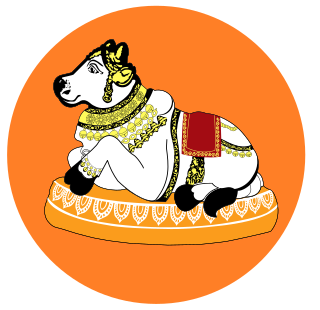
The Tevaram, also spelled Thevaram, denotes the first seven volumes of the twelve-volume collection Tirumurai, a Shaiva narrative of epic and Puranic heroes, as well as a hagiographic account of early Shaiva saints set in devotional poetry. The Tevaram volumes contain the works of the three most prominent Shaiva Tamil saints of the 7th and 8th centuries: Sambandar, Appar, and Sundarar. The three saints were not only involved in portraying their personal devotion to Shiva, but also engaged a community of believers through their songs. Their work is an important source for understanding the Shaiva Bhakti movement in the early medieval South India.

The Paadal Petra Sthalam, also known as Tevara Sthalam, are 276 temples that are revered in the verses of Shaiva Nayanars in the 6th-9th century CE. The Divya Desams by comparison are the 108 Vishnu temples glorified in the poems of the contemporary Vaishnava Alvars of Tamil Nadu, India.
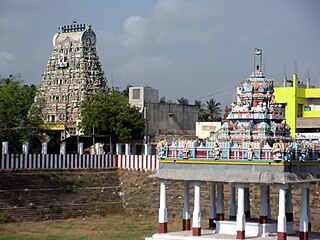
Thyagaraja Temple is a Hindu temple dedicated to Hindu god Shiva. It is located in Tiruvottiyur in the northern part of Chennai, Tamil Nadu, India. The temple is revered by the Tevaram hymns of Saiva nayanars, the 7th century Tamil saint poets and classified as Paadal Petra Sthalam. All the Three of Thevaram Moovar has rendered Thevaram songs in this temple. The temple is closely associated with the saint poet Sundarar and Pattinathar. The temple has been in vogue from the Pallava times of the 7th century and widely expanded by Chola kings during the 11th century. The temple has a seven tiered gateway tower, a tank, with the overall temple area covering 1 acre. The temple is administered by the Hindu Religious and Endowment Board of the Government of Tamil Nadu. The temple draws parallel with the Thygaraja temple in Tiruvarur as both the temples were expanded by Rajendra Chola I and both have the same dance poses of Shiva. The temple is one of the 51 Sakthi Peetams in the country.

Thyagaraja Temple is a Shiva temple, located in the town of Thiruvarur in Tamil Nadu state, India. Shiva is worshiped in the form of a lingam as Thyagarajaswami, also known as Putridankondar. His consort Parvati is worshipped as Goddess Neelotpalambika. She is also worshipped as Goddess Kamalambika, whose separate shrine is an important center for Shaktism and Tantra, and is also regarded to be one of the Shakti Peethas. The presiding deity is revered in the 7th century Shaiva canonical work, the Tevaram, written in Tamil by saint poets known as the Nayanars and the shrine is classified as a Paadal Petra Sthalam.
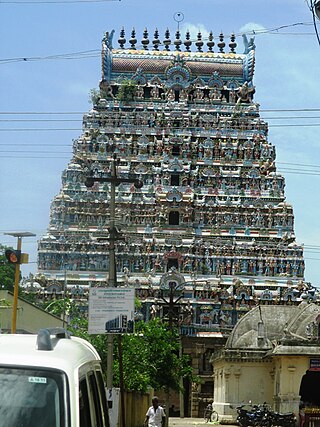
Mahalingeswaraswamy Temple, Thiruvidaimarudur is a Hindu temple dedicated to the deity Shiva, located in Tiruvidaimaruthur, a village in the South Indian state of Tamil Nadu. It is significant to the Hindu sect of Saivism as one of the seven major Shiva temples. Shiva is worshiped as Mahalingeswaraswamy, and is represented by the lingam, with his idol referred to as Jyothirmayalingam. His consort Mookambika is depicted as Devi Bruhatsundarakuchaambika or Bruhatsundarakuchaambigai amman. The lingam of the temple is believed to be the focal point for the seven consorts of Shiva. The presiding deity is revered in the 7th century Tamil Saiva canonical work, the Tevaram, written by Tamil poet saints known as the nayanars and classified as Paadal Petra Sthalam. The 9th century Saiva saint poet Manikkavacakar has sung praise about the temple in his works. Pattinattar, one of the revered saints visited this shrine many times.

Aiyarappar is a Hindu temple dedicated to Shiva located in the village of Tiruvaiyaru, Tamil Nadu, India. Shiva is worshiped as Aiyarappar, and is represented by the lingam and his consort Parvati is depicted as AramValarthaNaayagi. The presiding deity is revered in the 7th century Tamil Saiva canonical work, the Tevaram, written by Tamil poet saints known as the nayanars and classified as Paadal Petra Sthalam.

Kayarohanaswami Temple, Nagapattinam is a Hindu temple dedicated to Lord Siva situated in the town of Nagapattinam in Tamil Nadu, India. The presiding deity is known as Kayarohana and his consort is Nilayathakshi. The temple has been in existence from the 6th century CE and has been praised by the Nayanmars Appar, Sambandar and Sundarar. The temple has been constructed by the Lakolisa cult which originated in Gujarat and their only other temple in Tamil Nadu is at Kanchipuram. The idol of Thyagaraja in the temple is made of lapis lazuli.

Vedaranyeswarar Temple is a Hindu temple dedicated to the god Shiva, located in the town of Vedaranyam in Tamil Nadu, India. Vedaranyeswarar is revered in the 7th-century-CE Tamil Shaiva canonical work, the Tevaram, written by Tamil saint poets known as the Nayanars and classified as Paadal Petra Sthalam. It is the only temple to have found mention in all the seven Thirumurais. The temple is famed for the legend between the saints Appar and Sambandar when the former sang to open the door while the latter sang to close the door.
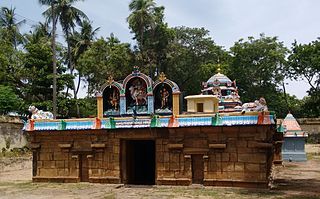
Chakramangai or Chakravageswarar Temple is a Hindu temple dedicated to Hindu deity Shiva and is located in Chakkarapalli, Papanasam taluk of Thanjavur district, Tamil Nadu, India. The temple is incarnated by the hymns of Thevaram, the 7th century Tamil literature and is classified as Paadal Petra Sthalam. It is one of the 275 Paadal Petra Sthalams, where the three of the most revered Nayanars, Appar and Tirugnana Sambandar have glorified the temple with their verses during the 7th-8th century. The temple has been widely expanded by Chola kings during the 11th century.

Nadutariappar Temple, Kanrappur is a Hindu temple dedicated to Shiva located at Kanrappur near Tiruvarur, Tamil Nadu, India. The temple is incarnated by the hymns of Appar and is classified as Paadal Petra Sthalam.

Pushpavananathar Temple is a Hindu temple dedicated to Shiva located in the village of Tiruppoonturutti near Tiruvaiyaru, Tamil Nadu, India. Shiva is worshiped as Aiyarappar, and is represented by the lingam and his consort Parvati is depicted as Soundaranayagi. The presiding deity is revered in the 7th century Tamil Saiva canonical work, the Tevaram, written by Tamil poet saints known as the nayanars and classified as Paadal Petra Sthalam.

Vedapuriswarar Temple, Thiruvedhikudi or Vazhaimadunathar Temple is a Hindu temple dedicated to Shiva located in Thiruvedhikudi near Tiruvaiyaru, Tamil Nadu, India. The presiding deity is revered in the 7th century Tamil Saiva canonical work, the Tevaram, written by Tamil poet saints known as the nayanars and classified as Paadal Petra Sthalam. The temple is counted as the earliest of all Chola temples.

Tirunallar Saniswaran Temple or Dharbaranyeswarar Temple is a Hindu temple dedicated to the deity Shiva, located in the Thirunallar village, in Karaikal district of Union territory of Puducherry.
Brahmapureeswarar Temple or Thiurkolili is a Hindu temple dedicated to Shiva located in Thirukkuvalai in Nagapattinam district of Tamil Nadu, India. Shiva is worshiped as Brahmapureeswarar, and is represented by the lingam and his consort Parvati is depicted as Vandamar Poonguzhali. The presiding deity is revered in the 7th-century-CE Tamil Saiva canonical work, the Tevaram, written by Tamil poet saints known as the nayanars and classified as Paadal Petra Sthalam.
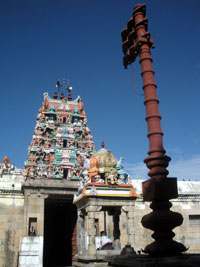
Kannayariamudayar Temple, Thirukkarayil is a Hindu temple dedicated to Shiva located in Thirukaravasal in Nagapattinam district of Tamil Nadu, India. Constructed in the Dravidian style of architecture, the temple is believed to have been built during the Cholas period in the 9th century CE. Shiva is worshipped as Kannayiranathar and his consort Parvathi as Kailasanayaki.
Atakeccuram Nagabilam Temple, Tiruvarur, is a Siva temple in Tiruvarur in Tiruvarur District in Tamil Nadu (India).

















